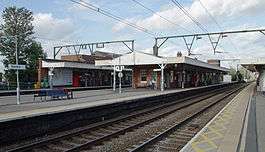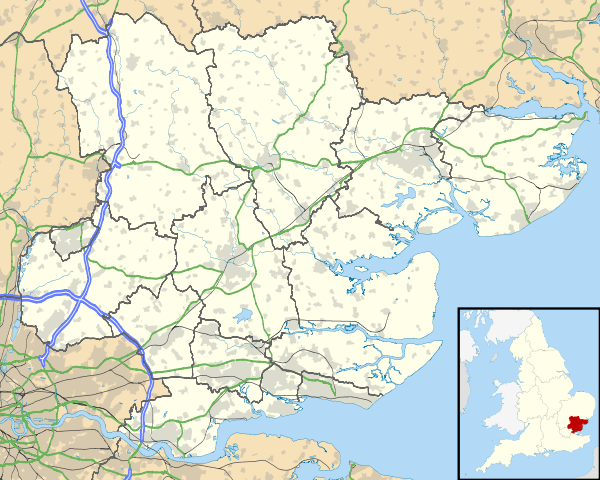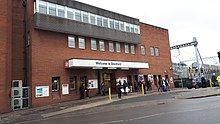Shenfield railway station
Shenfield railway station is on the Great Eastern Main Line in the East of England, serving the town of Shenfield, Essex. As well as being a key interchange for medium- and long-distance services on the main line, it is also the western terminus of a branch line to Southend Victoria and the eastern terminus of the stopping "metro" service to and from London Liverpool Street operated by TfL Rail. It is 20 miles 16 chains (32.51 km) down the line from Liverpool Street and is situated between Brentwood and either Ingatestone on the main line or Billericay on the branch line. Its three-letter station code is SNF.
| Shenfield | |
|---|---|
 | |
 Shenfield Location of Shenfield in Essex | |
| Location | Shenfield |
| Local authority | Borough of Brentwood |
| Grid reference | TQ613949 |
| Managed by | Greater Anglia |
| Owner | Network Rail |
| Station code | SNF |
| DfT category | B |
| Number of platforms | 6 |
| Accessible | Yes[1] |
| Fare zone | C |
| National Rail annual entry and exit | |
| – interchange | 1.895 million[2] |
| 2014–15 | |
| – interchange | |
| 2015–16 | |
| – interchange | |
| 2016–17 | |
| – interchange | |
| 2017–18 | |
| – interchange | |
| 2018–19 | |
| – interchange | |
| Railway companies | |
| Original company | Eastern Counties Railway |
| Pre-grouping | Great Eastern Railway |
| Post-grouping | London and North Eastern Railway |
| Key dates | |
| 29 March 1843 | Opened as Shenfield |
| March 1850 | Closed |
| 1 January 1887 | Reopened as Shenfield & Hutton Junction |
| 20 February 1969 | Renamed Shenfield |
| Other information | |
| External links | |
| WGS84 | 51.6307472°N 0.32972°E |
The station was opened in 1843 and has since expanded from its original three platforms to the current six.[3] It sees trains operated by Greater Anglia to main line destinations including Chelmsford, Witham and Ipswich, as well as branch line stations such as Southminster, Braintree, Harwich Town, Colchester Town and Clacton-on-Sea.

In the future the TfL Rail service will be re-branded as the Elizabeth line as part of the Crossrail project. Eventually, the Elizabeth line service from Shenfield will be extended beyond Liverpool Street through central London to Paddington and onwards to Reading and Heathrow Airport.
History
Shenfield station was opened by the Eastern Counties Railway company on 29 March 1843 on the extension from Brentwood to Colchester. As it was situated in a rural area, patronage was low, so it was closed in March 1850. It reopened with the name Shenfield & Hutton Junction on 1 January 1887 under the Great Eastern Railway to serve as an interchange station with the new line to Southend that was completed two years later. There were three platforms, two up (London-bound) and one down (country-bound). Under the London and North Eastern Railway, two extra tracks for terminating local (suburban "metro") trains opened in 1934, resulting in five platforms.
The 1920 survey of the station shows goods sidings and a turntable on the London side of the up platforms. The goods yard was closed on 4 May 1964 and it became the station's car park.[4] The Hutton Junction suffix in the station's name was removed on 20 February 1969.[5]
The station is 20 miles 16 chains (32.5 km) from Liverpool Street. Immediately west of the station is Brentwood bank, which descends steeply in the up (London) direction. This bank presented a significant climb to steam trains. There are extensive sidings on the London side of the station just before the start of the descent down the bank.
To the east of the station, the lines for Southend diverge to the south. West of Shenfield there are five tracks, but to the east these split, two towards Colchester and two towards Southend Victoria. The London and North Eastern Railway opened the Southend Loop to the east of the station on 1 January 1934. This enabled Southend trains to and from platforms 4 and 5 to dive-under the main line thus eliminating conflicting movements. The bi-directional loop line connects to the Southend line at Mountnessing Junction.
The lines from London Liverpool Street and London Fenchurch Street (via Gas Factory Junction and Bow Junction) to Shenfield were electrified at 1500 V DC overhead system in 1949. This was converted to 6.5 kV AC in 1960. Gidea Park to Shenfield was converted to 25 kV AC in 1976. Liverpool Street to Gidea Park was converted to 25 kV AC in 1980.[6]
Oyster card readers were installed for pay-as-you-go journeys in 2013.[7]
Today, Shenfield is served by fast trains on the main line towards London and it is also the eastern terminus of the stopping "metro" service from Liverpool Street. In the future Shenfield will additionally be one of two eastern termini of Crossrail (to be branded as the Elizabeth line), although the precursor company TfL Rail took over the existing "metro" service in May 2015.[8] Nine-carriage Class 345 trains will run over the pair of 'electric lines', rather than the main lines, replacing the existing eight-carriage "metro" trains and allowing Crossrail to serve all stations between Shenfield and Liverpool Street, continuing west to Paddington when the line opens fully.[9] At peak hours the frequency of service will increase from eight trains per hour to 12, necessitating the construction of a new 210-metre long platform 6,[9][10] which was built to the north of platform 5, replacing one of the existing three western sidings.[11] The two remaining western sidings and three new eastern sidings will also be used by Crossrail.[11] It is estimated that Crossrail will cut morning peak journey times by up to seven minutes although there will be no reduction to some journey times.[11] Platforms 1 to 5 have an operational length for 12 carriages, platform 6 for 10 carriages.[12]
Services
The typical off-peak service pattern at Shenfield is:
- 13 trains per hour (tph) to London Liverpool Street, of which:
- 3 tph to Southend Victoria, calling at all stations to Southend Victoria;
- 1 tph to Braintree, calling at Ingatestone, Chelmsford, Witham, then all stations to Braintree;
- 1 tph to Clacton-on-Sea, calling at Ingatestone, Chelmsford, Witham, Colchester, Wivenhoe, Thorpe-le-Soken and Clacton-on-Sea;
- 1 tph to Colchester Town, calling at Chelmsford, Witham then all stations to Colchester Town;
- 1 tph to Ipswich, calling at Chelmsford then all stations to Ipswich.
During peak times, service frequencies may be increased and calling patterns varied. Service frequencies are generally reduced on Sundays.
References
- "Step free Tube Guide" (PDF). Transport for London. May 2020. Archived (PDF) from the original on 7 August 2020.
- "Station usage estimates". Rail statistics. Office of Rail Regulation. Please note: Some methodology may vary year on year.
- "Shenfield's Crossrail services will start by the end of May". Essex Live. 8 May 2017. Archived from the original on 11 May 2017. Retrieved 15 June 2017.
- Mitchell, Victor E. (April 2011). Eastern Main Lines - Shenfield to Ipswich. Midhurst: Middleton Press. Plan II. ISBN 978 1 906008 96 3.CS1 maint: ref=harv (link)
- Mitchell 2011, Plate 4
- Modern Railways, March 2010, p. 44, and May 2010, p.35
- "Commissioners report" (PDF). TFL. December 2012. Retrieved 10 January 2013.
- "Capital's key services protected, says Johnson". The Press Association. 20 October 2010. Retrieved 21 October 2010.
- CROSSRAIL INFORMATION PAPER A7 – SELECTION OF THE NORTH EASTERN TERMINUS
- Environmental Baseline and Assessment of Impacts – North East Route Section
- Chapter 18 - Route Window NE17 - Shenfield station
- Martyn Brailsford (ed) (2016). Railway Track Diagrams Volume 2 Eastern. Frome: Trackmaps. pp. 5, 10. ISBN 978-0-9549866-8-1.CS1 maint: extra text: authors list (link)
External links
| Wikimedia Commons has media related to Shenfield railway station. |
- Train times and station information for Shenfield railway station from National Rail
- Excel file displaying National Rail station usage information for 2005/06
| Preceding station | Following station | |||
|---|---|---|---|---|
Stratford | Greater Anglia | |||
| Terminus | Greater Anglia Shenfield to Southend Line | |||
| Preceding station | Following station | |||
towards Liverpool Street | TfL Rail Shenfield Metro | Terminus | ||
| Future development | ||||
towards Paddington | Crossrail Elizabeth line | Terminus | ||